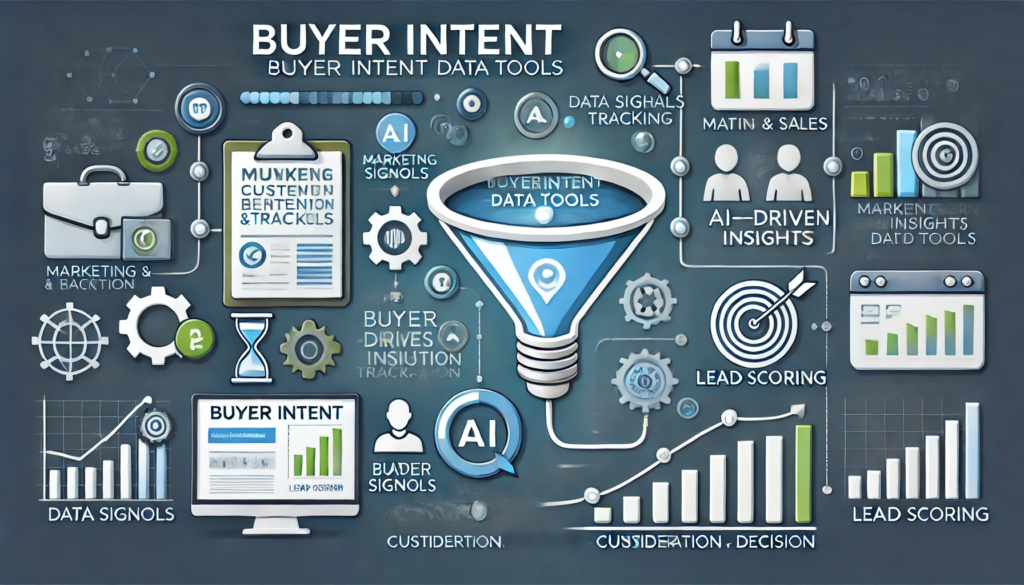Key Takeaways
- Buyer intent data tools help businesses identify high-intent leads by analyzing customer behavior and signals across multiple channels.
- These tools enable personalized marketing by delivering relevant content to prospects at the right moment in their buyer’s journey.
- Leveraging buyer intent data improves targeting, boosts conversion rates, and enhances overall sales strategies for business growth.
In today’s highly competitive digital landscape, businesses are constantly seeking ways to streamline their marketing strategies and drive better results.
One of the most powerful tools in this effort is Buyer Intent Data.
With an overwhelming amount of information available online, it has become increasingly challenging for businesses to identify who their most promising prospects are and what actions will convert them into loyal customers.
This is where Buyer Intent Data Tools come into play, offering marketers and sales teams invaluable insights into the behavior and intentions of potential buyers.

Buyer Intent Data is essentially the information that reveals how likely a consumer is to make a purchase based on their online activities, behaviors, and interactions with your brand or products.
By capturing signals such as page views, content downloads, social media interactions, and more, these tools provide a comprehensive view of a customer’s interests and their readiness to buy.
In an age where customer behavior is more unpredictable than ever, understanding these intent signals gives companies a crucial advantage in predicting future sales, optimizing marketing campaigns, and personalizing the buyer journey.
But how do Buyer Intent Data Tools actually work?
These sophisticated platforms utilize various methods, such as website tracking, AI-driven algorithms, and third-party data integration, to collect and analyze vast amounts of data.
They help businesses track key buyer actions in real-time, identify high-value leads, and measure the likelihood of conversion, all while delivering actionable insights.
Whether it’s identifying which leads are closest to making a purchase or understanding the specific content that influences decision-making, Buyer Intent Data Tools serve as the compass for businesses looking to navigate the complexities of modern customer behavior.
As companies continue to embrace data-driven decision-making, understanding and utilizing Buyer Intent Data becomes essential for any successful marketing strategy.
It not only helps organizations boost their lead generation efforts but also enhances the overall customer experience by allowing for more personalized, targeted communication. This introductory guide will delve into what Buyer Intent Data is, how these tools work, and why they are an indispensable asset for businesses seeking to optimize their sales and marketing processes.
Before we venture further into this article, we would like to share who we are and what we do.
About 9cv9
9cv9 is a business tech startup based in Singapore and Asia, with a strong presence all over the world.
With over nine years of startup and business experience, and being highly involved in connecting with thousands of companies and startups, the 9cv9 team has listed some important learning points in this overview of What are Buyer Intent Data Tools and How They Work.
If your company needs recruitment and headhunting services to hire top-quality employees, you can use 9cv9 headhunting and recruitment services to hire top talents and candidates. Find out more here, or send over an email to [email protected].
Or just post 1 free job posting here at 9cv9 Hiring Portal in under 10 minutes.
What are Buyer Intent Data Tools and How They Work
- What is Buyer Intent Data?
- How Buyer Intent Data Tools Work
- Key Features of Buyer Intent Data Tools
- Benefits of Using Buyer Intent Data Tools
- How to Choose the Right Buyer Intent Data Tool for Your Business
- Use Cases of Buyer Intent Data Tools
- Challenges of Using Buyer Intent Data Tools
- The Future of Buyer Intent Data Tools
1. What is Buyer Intent Data?
Buyer Intent Data refers to the signals and insights that indicate a potential customer’s likelihood of making a purchase. By analyzing consumer behavior, businesses can better understand where a buyer is in their decision-making process and identify when they are ready to take action. This data can come from multiple sources such as website interactions, content consumption, social media behavior, and more, providing a more comprehensive view of the buyer’s interests and readiness to engage.
Buyer Intent Data essentially helps companies understand the “why” behind customer behavior, enabling them to tailor their marketing efforts effectively. This allows businesses to focus their resources on leads that are more likely to convert, resulting in better lead qualification and improved sales outcomes. Let’s break down the concept further into key components.
Types of Buyer Intent Data
Buyer Intent Data can be classified into three primary types:
- Behavioral Data
- What it is: This data is gathered based on what users do on your website, social media, or other digital platforms.
- Examples:
- A visitor frequently visits your pricing page, showing interest in purchasing.
- A customer spends significant time on a product or service comparison page.
- Downloads or interaction with case studies and whitepapers, indicating interest in your offerings.
- Predictive Data
- What it is: This data uses AI and machine learning algorithms to predict future buying behavior based on past actions.
- Examples:
- If a lead has previously interacted with your site and shown high engagement, predictive models may indicate they are likely to convert soon.
- Previous searches or interactions on your competitor’s website may trigger predictive signals that they are in the market for similar products.
- Contextual Data
- What it is: This data includes insights into the buyer’s situation, such as their location, the time of day, and the device they are using.
- Examples:
- A visitor who accesses your site from a mobile device late at night may be browsing casually, while a desktop visitor during business hours could be more engaged.
- Leads interacting with specific promotional content may indicate a heightened intent to buy.
Buyer Intent Data and Its Role in the Customer Journey
Buyer Intent Data plays a critical role throughout the entire customer journey, from awareness to consideration and ultimately decision-making. By tracking intent signals, businesses can gain insight into how far along a potential buyer is in their purchasing decision, and adjust their marketing approach accordingly.
- Awareness Stage
- Signals: Visitors may consume content that addresses their pain points, such as blog posts, infographics, or educational webinars.
- Example: A prospect reads multiple blog posts on “how to optimize digital marketing strategies” but hasn’t yet engaged with product-related pages.
- Actionable Insight: You can nurture these leads with more informative content or awareness-stage ads to educate them further about your offerings.
- Consideration Stage
- Signals: Leads might engage with comparison tools, product descriptions, or pricing information.
- Example: A lead checks the features, benefits, and pricing of several of your products or services, comparing them to competitors.
- Actionable Insight: This intent signal indicates they are considering your solution seriously. You can offer targeted discounts or case studies to encourage them to choose your product.
- Decision Stage
- Signals: Leads are highly engaged with specific products or services and may be filling out forms, requesting demos, or contacting sales teams.
- Example: A lead downloads a product brochure and asks for a demo within a day or two.
- Actionable Insight: These high-intent actions suggest that the lead is nearing a purchase decision. A personalized follow-up from your sales team or a time-sensitive offer could help close the deal.
How Buyer Intent Data is Collected
The process of collecting Buyer Intent Data typically involves gathering information from multiple touchpoints, both online and offline, and integrating them into a centralized platform.
- Website Activity
- How it works: Tracking interactions on your website, such as page views, time spent on specific pages, clicks on CTAs, and form submissions.
- Example: If a lead spends considerable time on the “Pricing” page of your website, it’s a clear indicator that they are assessing the value and are close to making a purchase.
- Third-Party Data Sources
- How it works: Leveraging external platforms that track broader consumer behavior across multiple websites and touchpoints.
- Example: Tools like Bombora and G2 track intent signals from third-party websites, providing insights into whether a potential customer is exploring products or services similar to yours.
- Social Media Monitoring
- How it works: Tracking social media activity, such as shares, likes, comments, and engagement with posts related to your brand or industry.
- Example: A lead who frequently shares or comments on posts about your product’s features may indicate high intent, especially if they’re asking specific questions about functionality.
- Email Interactions
- How it works: Monitoring how recipients engage with your marketing emails—whether they open, click, or respond.
- Example: If a recipient opens a pricing email multiple times, it shows a strong interest in buying.
Why Buyer Intent Data is Valuable for Businesses
Buyer Intent Data is valuable because it enables businesses to make more informed decisions, allocate resources effectively, and improve conversion rates. Below are some of the key benefits that make Buyer Intent Data indispensable:
- Optimized Lead Generation
- Helps businesses identify leads who are more likely to convert, saving marketing resources and effort.
- Example: Instead of chasing cold leads, businesses can focus on high-intent prospects who have already shown interest in their product or service.
- Personalized Marketing
- Allows for the delivery of highly personalized content and messaging tailored to the buyer’s interests and buying stage.
- Example: If a lead is browsing for specific features or is comparing options, sending them case studies or testimonials that highlight those specific features can increase engagement.
- Improved Sales Effectiveness
- Sales teams can prioritize leads based on intent signals, focusing their efforts on prospects who are more likely to make a purchase.
- Example: A salesperson can approach a lead who has visited the demo request page multiple times and offer them a personalized consultation.
- Faster Sales Cycles
- Identifying high-intent leads early allows businesses to fast-track them through the sales funnel, reducing the time it takes to close deals.
- Example: A lead who engages heavily with product demos or pricing pages is likely ready for a direct conversation with a sales representative, accelerating the sales cycle.
Examples of Buyer Intent Data in Action
- E-commerce Industry
- Scenario: An online clothing retailer tracks users who visit the product pages of certain items, add them to the cart, but abandon the cart without completing the purchase.
- Intent Data Insight: The retailer can follow up with a targeted email offering a discount on the abandoned items, increasing the chances of converting the lead.
- B2B Lead Generation
- Scenario: A SaaS company tracks that a potential client has visited their pricing page, downloaded product brochures, and viewed customer testimonials.
- Intent Data Insight: This indicates that the lead is in the decision stage, and the sales team can approach them with personalized offers or a demo to close the deal.
By understanding and leveraging Buyer Intent Data, businesses can significantly improve the effectiveness of their marketing and sales strategies, ensuring they are targeting the right leads with the right message at the right time.
2. How Buyer Intent Data Tools Work
Buyer Intent Data Tools are sophisticated platforms designed to collect, analyze, and interpret signals from potential customers to determine their likelihood of making a purchase. By tracking a variety of digital footprints left by users—such as web behavior, content interaction, and social media activity—these tools provide actionable insights that help businesses understand where prospects are in their buyer journey and how ready they are to engage. Let’s break down the functionality of Buyer Intent Data Tools in detail, showcasing how they gather and process data, and the specific ways they benefit businesses.
1. Data Collection Methods Used by Buyer Intent Data Tools
Buyer Intent Data Tools employ a variety of data collection techniques to track and analyze buyer behavior across multiple touchpoints. These tools typically integrate with websites, CRM systems, and third-party data sources to gather the most relevant data on leads.
Website Tracking and Behavioral Data
- Page Views and Click Patterns:
- Buyer Intent Data Tools monitor the specific pages that visitors interact with on your website, such as product pages, pricing details, and educational content.
- Example: A tool may track how long a visitor spends on a product comparison page, indicating interest in a particular feature.
- Heatmaps:
- Heatmaps visualize the areas of a webpage where visitors engage most, showing which content grabs their attention.
- Example: If a visitor clicks on a CTA (call-to-action) button multiple times, the tool can flag this interaction as an intent signal for further nurturing.
- Session Replay:
- This tool records user sessions, allowing businesses to watch how prospects navigate through the site.
- Example: If a visitor goes from browsing blog content to checking out product features and specifications, this indicates a progression in interest.
Third-Party Data Integration
- Intent Data Providers:
- Some Buyer Intent Data Tools integrate with external intent data providers (such as Bombora or G2), which track buyer behavior across multiple websites to provide more comprehensive insights.
- Example: A company may partner with G2 to monitor users browsing software solutions similar to their product, identifying when a prospect is actively researching alternatives.
- Social Media Monitoring:
- Buyer Intent Data Tools also track social media interactions, identifying when a user engages with relevant hashtags, shares a post, or comments on industry-specific content.
- Example: If a prospect tweets about challenges related to marketing automation, this could trigger an intent signal to a marketer offering automation solutions.
- CRM and Email Engagement:
- Integration with customer relationship management (CRM) systems allows tools to analyze how leads engage with email marketing campaigns, including which links are clicked and how often emails are opened.
- Example: A prospect opening a pricing email multiple times is a clear signal that they are considering making a purchase.
2. Data Processing and Analysis
Once Buyer Intent Data Tools collect the necessary data, they must process and analyze it to generate meaningful insights that businesses can act upon. The use of AI, machine learning, and predictive analytics plays a key role in this phase.
Behavioral Scoring and Lead Scoring
- Behavioral Scoring:
- The tools assign scores to leads based on their actions. For example, visiting a pricing page could give a lead a higher score than simply reading a blog post.
- Example: A prospect downloading a product demo might be assigned a high behavioral score, signaling that they are nearing the decision-making stage.
- Lead Scoring:
- By evaluating both demographic and behavioral data, Buyer Intent Data Tools assign a score to each lead, indicating how likely they are to convert. High scores suggest a greater likelihood of purchase.
- Example: A lead with a high score may have downloaded a white paper, watched a product demo, and requested more information, indicating strong buying intent.
Predictive Analytics and Machine Learning
- Predictive Modeling:
- AI-powered tools predict future behavior based on historical data, helping to assess which leads are more likely to convert. The system uses patterns and algorithms to forecast buyer actions.
- Example: A tool might predict that a lead who frequently checks the pricing page and views testimonials will likely make a purchase within the next week.
- Dynamic Insights:
- Machine learning algorithms allow Buyer Intent Data Tools to continually adjust the analysis based on new data, improving the accuracy of predictions over time.
- Example: If a lead’s behavior shifts, such as a drop in engagement, the tool will adjust their score accordingly and suggest new strategies for re-engagement.
3. Real-Time Data and Alerts
Buyer Intent Data Tools not only track long-term behavior but also offer real-time data processing and alerts, enabling businesses to react instantly to buyer actions.
Instant Alerts for Sales Teams
- Actionable Alerts:
- When a lead exhibits high-intent behavior (e.g., requesting a demo, submitting a form, or viewing pricing), the system can send an immediate alert to the sales team, allowing for quick follow-up.
- Example: A sales representative may receive an alert the moment a prospect downloads a product brochure, prompting them to initiate a timely follow-up.
Customizable Alerts and Notifications
- Behavior-Based Notifications:
- Sales and marketing teams can set specific triggers for notifications based on desired customer behaviors, ensuring they focus on the most valuable leads.
- Example: Setting up an alert for when a lead spends over 10 minutes on a product-specific landing page can help the sales team engage at the most opportune moment.
4. Integration with Marketing Automation and CRM Systems
Buyer Intent Data Tools work best when they seamlessly integrate with existing systems such as marketing automation platforms and CRMs. This integration ensures that the data is utilized effectively for lead nurturing and conversion.
Automated Lead Nurturing
- Personalized Email Campaigns:
- Once a high-intent lead is identified, Buyer Intent Data Tools can trigger automated, personalized email campaigns to guide the lead further down the sales funnel.
- Example: After identifying a lead who has visited your product page multiple times, an automated email with a special offer or additional product information can be sent.
- Lead Segmentation:
- By integrating with marketing automation tools, Buyer Intent Data Tools can help segment leads into different groups based on their intent data and behavior, enabling more personalized marketing efforts.
- Example: Leads who are actively engaging with your pricing page can be grouped for targeted promotional emails, while those who are still in the awareness stage may receive educational content.
CRM Integration for Sales Enablement
- Sales Funnel Visibility:
- Integrating with CRMs like Salesforce allows sales teams to get a full view of where each lead stands in the sales funnel, informed by the intent data they’ve generated.
- Example: A CRM system may display that a lead has visited the website multiple times, opened several emails, and engaged with customer reviews, indicating strong intent to buy.
- CRM Updates and Actions:
- As lead behaviors evolve, Buyer Intent Data Tools can automatically update lead records within the CRM, prompting sales reps to take the appropriate actions.
- Example: If a lead moves from the consideration to the decision stage based on their activities, the sales team is alerted, allowing them to tailor their outreach strategy.
5. Visual Dashboards and Reporting
To make sense of all the data collected and analyzed, Buyer Intent Data Tools provide businesses with intuitive dashboards that present clear, actionable insights.
Data Visualization
- Custom Dashboards:
- Customizable dashboards allow users to visualize key metrics, such as the most engaged leads, high-intent actions, and conversion probabilities.
- Example: A dashboard may show a spike in intent scores for leads in a particular industry, signaling an opportunity for tailored outreach.
- Actionable Reports:
- Detailed reports can be generated to review historical performance, identify trends in buyer behavior, and optimize future marketing efforts.
- Example: A report highlighting the most frequent actions taken by converted leads may reveal which content pieces are the most effective in driving sales.
Conclusion: The Impact of Buyer Intent Data Tools
Buyer Intent Data Tools significantly enhance the accuracy and efficiency of lead generation, marketing, and sales strategies. By leveraging advanced data collection, predictive analytics, real-time insights, and seamless integrations, these tools provide businesses with the insights they need to identify high-quality leads, personalize engagement, and drive conversions. Whether it’s through real-time alerts, automated follow-ups, or predictive modeling, Buyer Intent Data Tools ensure that businesses are always one step ahead in nurturing their most promising prospects.
3. Key Features of Buyer Intent Data Tools
Buyer Intent Data Tools offer a range of features designed to capture, analyze, and act on the signals from prospects that indicate their likelihood of making a purchase. These tools combine advanced technologies such as machine learning, artificial intelligence, and predictive analytics to provide businesses with a comprehensive understanding of potential customers. The following key features are central to their functionality and provide invaluable insights to sales and marketing teams.
1. Data Collection from Multiple Sources
The foundation of Buyer Intent Data Tools is their ability to gather data from various digital touchpoints, providing a holistic view of buyer behavior. These tools integrate with various platforms to track a wide array of customer interactions and activities.
Web and On-Site Tracking
- Page Views and Content Engagement:
- Buyer Intent Data Tools monitor which pages prospects visit, how long they stay on specific pages, and what content they engage with the most.
- Example: If a visitor spends significant time on a product demo page, this can indicate high interest in learning more about the product.
- Heatmaps:
- Tools often use heatmaps to track where users click and how they navigate through websites.
- Example: If a user frequently clicks on a particular feature or product, it signals specific interest in that feature.
- Session Replay:
- Some Buyer Intent Data Tools offer session replay features, allowing businesses to watch how leads interact with their website in real-time.
- Example: A sales rep might notice that a lead watches a product tutorial multiple times, which can be a key signal of their readiness to convert.
Third-Party Data Integration
- Intent Data Providers:
- Many Buyer Intent Data Tools integrate with third-party intent data sources like Bombora, G2, or TechTarget to track online behavior across a variety of websites, revealing valuable signals of interest.
- Example: A company may see that a lead is researching similar products on third-party sites, which could trigger a follow-up from the sales team.
- Social Media Monitoring:
- Social media engagement is another critical area, as Buyer Intent Data Tools track interactions on platforms like LinkedIn, Twitter, and Facebook.
- Example: If a potential lead shares a post about marketing automation, this could trigger the system to flag them as a high-intent prospect for related solutions.
2. Lead Scoring and Behavioral Analytics
One of the most valuable features of Buyer Intent Data Tools is their ability to score leads based on their behavior and engagement, helping businesses prioritize high-intent prospects.
Behavioral Lead Scoring
- Tracking Key Actions:
- Buyer Intent Data Tools assign scores to leads based on their behaviors, such as content downloads, demo requests, and page visits.
- Example: A lead downloading an eBook and then attending a product demo could receive a higher score, indicating strong buying intent.
- Real-Time Adjustments:
- The lead scoring model continuously adjusts as new behavior is recorded, ensuring that businesses can react to the most current signals.
- Example: If a lead initially showed moderate interest but suddenly views a pricing page or requests a quote, their score might increase in real-time.
Predictive Analytics for Lead Scoring
- Predictive Modeling:
- Many tools use predictive analytics to estimate the likelihood of a lead converting based on historical data and past behavior patterns.
- Example: A prospect who browsed product pages and compared features in the past but has now started engaging with case studies is more likely to convert, according to the tool’s predictive model.
- High-Intent Predictions:
- By analyzing historical data from similar leads, Buyer Intent Data Tools can forecast which prospects are more likely to buy soon.
- Example: A buyer who is showing signs of comparison shopping (e.g., reviewing competitors’ sites) may be predicted to be in the decision-making stage.
3. Real-Time Alerts and Notifications
Real-time alerts are crucial for quickly responding to high-intent leads, ensuring that sales teams can act on important signals without delay.
Instant Alerts for Sales Teams
- Customizable Alerts:
- Sales teams can configure alerts to be notified of specific behaviors such as when a prospect revisits the site or requests a demo.
- Example: If a lead spends over 5 minutes on a pricing page, the system can send an alert to the sales team to follow up immediately.
- Prioritizing Hot Leads:
- Alerts help sales teams prioritize high-intent leads, ensuring that they don’t miss any opportunities to convert prospects at a critical stage.
- Example: A prospect who visits the site multiple times in one week and requests a consultation can be flagged as high priority.
Instant Actionability
- Prompt Follow-Up Actions:
- Upon receiving an alert, sales teams can quickly take action by reaching out to the lead via email, phone, or other channels to nurture the prospect.
- Example: A sales representative might receive an alert that a lead has just downloaded a white paper and can immediately send a personalized follow-up message, referencing the content the lead interacted with.
4. CRM and Marketing Automation Integration
Buyer Intent Data Tools become significantly more powerful when integrated with existing CRM and marketing automation platforms, creating a seamless flow of data between marketing and sales teams.
Seamless CRM Integration
- Enriching Lead Data:
- Integrating Buyer Intent Data Tools with CRM systems like Salesforce enables sales teams to view intent signals alongside other lead data, offering a comprehensive view of the lead’s journey.
- Example: A sales rep may see a lead’s past interactions, including email opens, downloads, and website visits, alongside the intent data, allowing for highly targeted follow-ups.
- Sales Funnel Visibility:
- The integration allows sales teams to track how leads move through the sales funnel, adjusting their approach based on where the lead stands.
- Example: A lead who has shown high intent by repeatedly visiting pricing pages can be moved into a “hot lead” category in the CRM, prompting timely outreach from sales.
Marketing Automation Workflows
- Automated Lead Nurturing:
- With marketing automation systems in place, Buyer Intent Data Tools can trigger personalized campaigns based on a lead’s behavior and intent.
- Example: If a lead engages with a demo video, the system can automatically send a series of emails with case studies, product features, and customer testimonials to further nurture the lead.
- Segmented Campaigns:
- Tools can segment leads based on their intent data, allowing marketing teams to create customized campaigns for different buyer personas and intent levels.
- Example: A lead showing interest in a particular feature of a product can receive tailored content that highlights that feature, while another lead showing interest in pricing can receive special offers.
5. Reporting and Analytics
Buyer Intent Data Tools often provide in-depth reporting features that allow businesses to measure the success of their intent-based strategies and optimize them over time.
Comprehensive Dashboards
- Customizable Reporting Dashboards:
- Dashboards provide a visual representation of key metrics, such as the number of high-intent leads, conversion rates, and engagement levels.
- Example: A marketing team can track how many leads moved from the awareness to the decision-making stage, helping them assess the effectiveness of their content and engagement strategies.
- Lead Journey Tracking:
- Detailed reports track the lead journey, showing which touchpoints influenced the conversion and providing insights for future campaigns.
- Example: A report might show that leads who first interacted with a product review page were more likely to request a demo, suggesting that reviews play a significant role in the decision-making process.
Trend Analysis
- Identifying Patterns in Intent Data:
- Buyer Intent Data Tools often provide trend analysis that helps businesses identify patterns in customer behavior over time.
- Example: A tool may show that a certain time of year generates higher engagement from leads, prompting businesses to ramp up marketing efforts during peak months.
- Optimization Opportunities:
- By analyzing historical data, businesses can optimize their lead generation strategies, focusing on tactics that have proven to drive high-intent prospects.
- Example: If certain content pieces or keywords lead to more high-intent actions, these can be prioritized in future campaigns.
6. AI-Powered Predictive Features
AI and machine learning are at the core of many Buyer Intent Data Tools, enabling them to predict future behavior based on historical data.
Predicting Conversion Likelihood
- Forecasting Buyer Behavior:
- AI-driven predictive analytics can forecast which leads are most likely to convert and when.
- Example: A lead who has been engaging with the site for several weeks and has shown interest in several product features might be predicted to purchase within the next 30 days.
- Behavioral Predictive Scoring:
- Predictive features can score leads based on their likelihood to buy, enabling sales teams to focus on the most promising prospects.
- Example: A lead who frequently engages with product demo videos but has not yet reached out may be flagged as a high-potential lead ready for conversion.
Conclusion
The key features of Buyer Intent Data Tools are essential for identifying and capitalizing on high-intent prospects, enabling businesses to tailor their marketing and sales efforts effectively. From data collection and predictive analytics to real-time alerts and CRM integration, these tools provide a comprehensive suite of capabilities that enhance lead management and optimize sales conversion rates. By leveraging these features, companies can gain a competitive edge, ensuring they engage with the right leads at the right time with the right message.
4. Benefits of Using Buyer Intent Data Tools
Buyer Intent Data Tools are becoming an integral part of modern sales and marketing strategies. By providing insights into customer behavior, these tools help businesses understand their prospects’ needs, preferences, and buying intentions. With the power to analyze vast amounts of data in real-time, Buyer Intent Data Tools can drive more effective decision-making, increase conversion rates, and optimize marketing efforts. Below, we will explore the key benefits of utilizing these tools, with relevant examples to illustrate their impact.
1. Improved Lead Qualification and Prioritization
One of the most significant advantages of Buyer Intent Data Tools is their ability to qualify and prioritize leads effectively. By analyzing buyer signals and behaviors, these tools help businesses identify high-intent prospects who are more likely to convert.
Accurate Lead Scoring
- Behavior-Based Lead Scoring:
- These tools assign scores to leads based on specific behaviors, such as visits to product pages, content downloads, and time spent on the website.
- Example: A lead who downloads multiple product brochures and views case studies is likely a higher priority than someone just visiting the homepage, indicating strong interest in purchasing.
- Real-Time Adjustments:
- Lead scores are adjusted in real-time as prospects engage with content, helping sales teams prioritize leads who are showing increased buying intent.
- Example: A lead who revisits the website several times and views pricing pages will see their score increase, signaling the need for immediate follow-up.
Identifying High-Intent Leads
- Predictive Insights:
- Predictive analytics allow businesses to forecast which leads are most likely to make a purchase based on their online behaviors.
- Example: A lead who has researched specific product features and requested a demo is more likely to convert compared to a lead who has only engaged with blog posts.
- Focus on Ready-to-Buy Prospects:
- By identifying leads who exhibit signs of high intent, sales teams can focus their efforts on prospects that are closer to the decision-making stage, saving time and resources.
- Example: Sales teams can target leads who frequently engage with competitor comparison pages, as they are in the decision phase of their buyer journey.
2. Enhanced Personalization of Sales and Marketing Efforts
Buyer Intent Data Tools enable businesses to deliver highly personalized messaging and offers to prospects, increasing the chances of engagement and conversion.
Tailored Content Delivery
- Content Recommendations Based on Behavior:
- By analyzing the pages and content that leads interact with, these tools allow businesses to recommend personalized content that aligns with the lead’s interests.
- Example: A prospect who browses customer success stories can be sent personalized emails featuring similar case studies that highlight how the product solved a particular challenge.
- Dynamic Website Content:
- Intent data can be used to dynamically change the content on the website based on the visitor’s interests, increasing engagement and guiding them towards conversion.
- Example: A lead who frequently visits a pricing page might be shown a special discount or an offer to schedule a one-on-one consultation with a sales rep.
Customized Outreach at the Right Time
- Real-Time Lead Engagement:
- By understanding when a lead is actively researching a product or service, businesses can initiate timely outreach with highly relevant offers and solutions.
- Example: If a lead views a pricing page multiple times, the sales team can follow up with a personalized email offering a limited-time promotion to push the prospect closer to purchase.
- Contextual Conversations:
- Sales teams can use Buyer Intent Data to tailor their conversations, addressing specific pain points or needs the prospect has shown interest in.
- Example: If a lead has been engaging with content about a particular product feature, the sales rep can focus on demonstrating that feature during a follow-up call or demo.
3. Better Forecasting and Sales Strategy
Buyer Intent Data Tools help businesses better forecast sales performance by providing detailed insights into how leads are engaging with their products or services. This data can be used to shape long-term sales strategies and improve revenue predictions.
Accurate Sales Projections
- Predictive Analytics for Sales Forecasting:
- By analyzing buyer intent signals, businesses can predict future buying behavior and estimate how many leads are likely to convert in a given period.
- Example: If a high percentage of leads visiting product pages show intent to purchase, businesses can project an increase in sales for the upcoming quarter based on these trends.
- Lead-to-Customer Conversion Rates:
- Intent data can help businesses calculate more accurate conversion rates, providing insights into how well leads are being nurtured and closed.
- Example: If 30% of leads showing high intent are converting, businesses can adjust their sales strategies to focus more on high-intent prospects, improving overall efficiency.
Optimizing Sales Campaigns
- Understanding Buyer Journey Stages:
- With Buyer Intent Data, businesses can gain insights into where leads are in their buyer journey, allowing them to tailor campaigns and messaging accordingly.
- Example: A lead who has shown interest in the product features but hasn’t yet requested a demo might receive content that highlights the product’s value proposition or benefits.
- Refining Sales Tactics:
- Businesses can refine their sales tactics based on which engagement strategies are most effective for different segments of their audience.
- Example: If a particular email sequence leads to higher conversions for leads showing interest in pricing, this sequence can be used more often or fine-tuned to increase engagement further.
4. Increased Conversion Rates
The ultimate goal of any sales or marketing effort is to convert leads into customers, and Buyer Intent Data Tools are powerful at driving higher conversion rates through more targeted and timely outreach.
Engaging Leads at Critical Points
- Focusing on High-Intent Leads:
- By identifying leads who are showing clear buying intent, businesses can avoid wasting time on low-intent leads and engage with those who are ready to make a purchase.
- Example: A lead who requests a product demo after multiple visits to the site is significantly closer to conversion than someone just browsing. Engaging them promptly can increase the chances of closing the deal.
- Nurturing Leads with Targeted Campaigns:
- These tools enable businesses to nurture leads with content and offers that resonate with their current stage in the buyer’s journey, increasing the likelihood of conversion.
- Example: A lead who engages with content on product features and benefits may be best nurtured with detailed product comparisons, case studies, or customer testimonials.
Reduced Time-to-Conversion
- Streamlined Follow-Up Process:
- With real-time alerts, sales teams can quickly follow up on high-intent leads, reducing the time between initial contact and conversion.
- Example: A lead who visits a pricing page multiple times within a short period can be contacted by a sales rep within minutes, significantly reducing the time it takes to convert that lead into a customer.
- Optimized Sales Funnels:
- By understanding how leads progress through the sales funnel, businesses can optimize their processes and shorten the sales cycle.
- Example: If Buyer Intent Data indicates that a lead is more likely to convert after viewing a specific type of content, businesses can focus their funnel on pushing leads toward that content earlier in the process.
5. Better Customer Insights and Market Understanding
Buyer Intent Data Tools not only help businesses engage with leads but also offer valuable insights into customer behavior and preferences, which can improve product offerings and marketing strategies.
Gaining a Deeper Understanding of Customers
- Tracking Behavior Across Multiple Channels:
- These tools allow businesses to track buyer behavior across various channels such as websites, social media, email, and third-party sites, providing a comprehensive view of customer preferences.
- Example: A business can track a lead’s interest in a particular product category across its website and social media, helping them understand what features or benefits are most important to that customer.
- Segmenting Audiences More Effectively:
- By analyzing Buyer Intent Data, businesses can segment their audience based on interests, buying behaviors, and intent levels, enabling more effective marketing and outreach.
- Example: A company could segment leads who are interested in pricing from those who are more interested in learning about product features, tailoring messaging to each group’s unique needs.
Identifying New Market Opportunities
- Recognizing Emerging Trends:
- With Buyer Intent Data, businesses can spot emerging trends or shifts in consumer behavior, helping them stay ahead of the competition.
- Example: If a specific feature of a product gains increasing attention over time, businesses can capitalize on this trend by creating targeted campaigns or enhancing that feature.
- Market Segmentation for New Products:
- Analyzing buyer intent can help businesses identify gaps in the market or underserved segments, enabling them to launch new products or services that meet emerging needs.
- Example: If a company notices that many prospects are searching for a specific type of product, they can consider introducing that product to cater to growing demand.
Conclusion
The benefits of using Buyer Intent Data Tools are extensive, ranging from more efficient lead qualification and prioritization to improved sales forecasting and increased conversion rates. By enabling highly personalized outreach, streamlining the sales process, and providing valuable customer insights, these tools give businesses a competitive advantage in today’s fast-paced market. Ultimately, they help sales and marketing teams focus on the right leads at the right time, ensuring that their efforts result in higher ROI and stronger customer relationships.
5. How to Choose the Right Buyer Intent Data Tool for Your Business
Choosing the right Buyer Intent Data Tool is crucial to maximizing your sales and marketing efforts. With so many tools available in the market, it can be overwhelming to determine which one best suits your business needs. However, understanding the key features, integration capabilities, and overall value of these tools can guide you toward making an informed decision. In this section, we’ll explore the essential factors to consider when selecting a Buyer Intent Data Tool and provide practical examples to help illustrate each point.
1. Understand Your Business Needs and Objectives
Before diving into specific features and tool comparisons, it’s important to clearly define your business goals. The right Buyer Intent Data Tool should align with your overall sales and marketing objectives.
Define Your Sales and Marketing Goals
- Lead Generation Goals:
- Are you focused on increasing the number of qualified leads? If so, look for a tool that offers powerful lead scoring and segmentation capabilities.
- Example: A B2B tech company that wants to identify high-potential leads may benefit from a tool that scores leads based on intent signals like product page visits, whitepaper downloads, and demo requests.
- Conversion Optimization:
- Do you aim to increase conversions by engaging high-intent leads at the right time? If conversion is your priority, opt for a tool that offers real-time alerts and automated follow-up triggers.
- Example: An eCommerce company looking to reduce cart abandonment might use a Buyer Intent Data Tool that automatically sends personalized discount offers to users who abandon their carts.
- Customer Retention:
- Are you focused on retaining existing customers or improving repeat sales? Some tools specialize in tracking post-purchase behavior and helping businesses increase customer loyalty.
- Example: A SaaS company offering subscription-based services may choose a tool that tracks user engagement and identifies customers who are at risk of churning.
Consider Your Target Audience
- B2B vs. B2C:
- B2B businesses may need a tool that specializes in tracking complex buyer journeys and multiple decision-makers, whereas B2C businesses may prioritize tools that focus on individual consumer behaviors.
- Example: A B2B company selling enterprise software might look for a tool that helps identify the intent of multiple stakeholders involved in the decision-making process, while a B2C brand may prioritize tools that track customer behavior like clicks, views, and purchases.
- Industry-Specific Needs:
- Different industries have unique needs when it comes to Buyer Intent Data. Understanding your industry’s specific requirements can help you choose the right tool.
- Example: A real estate agency may need a tool that tracks buyer intent signals like property page visits and inquiry forms, while a fintech company may require tools that track market trends and investment interest.
2. Evaluate the Key Features of the Tool
Buyer Intent Data Tools offer a range of features designed to help businesses track, analyze, and act on buyer behaviors. Understanding these features and how they align with your goals will help you make a better decision.
Lead Scoring and Segmentation
- Behavioral Lead Scoring:
- The ability to score leads based on their online activities (e.g., visiting a pricing page, downloading resources, etc.) is a must-have feature for any Buyer Intent Data Tool.
- Example: A tool that assigns high scores to leads who repeatedly visit product pages and engage with content helps your team prioritize follow-up efforts on the most promising prospects.
- Advanced Segmentation:
- Look for tools that allow you to segment leads based on different buyer intent signals and behaviors, such as content consumption patterns, product interest, and demographic data.
- Example: A marketing team can segment leads into high, medium, and low-intent groups based on their activity, allowing for more tailored messaging.
Real-Time Analytics and Reporting
- Real-Time Alerts:
- A great Buyer Intent Data Tool should provide real-time notifications when high-intent leads take specific actions, such as downloading a whitepaper or requesting a demo.
- Example: A sales team can receive instant notifications when a lead shows strong buying signals, allowing them to reach out immediately and improve conversion chances.
- Comprehensive Analytics and Dashboards:
- Look for a tool that offers in-depth analytics, helping you understand buyer behaviors across multiple channels and gain insights into which actions lead to conversions.
- Example: A tool that tracks lead journeys from initial website visits to conversion points (e.g., purchasing or filling out a contact form) helps businesses understand their most effective marketing strategies.
Predictive Analytics
- Forecasting Sales and Conversions:
- Predictive analytics can help you understand which leads are most likely to convert based on historical data and intent signals.
- Example: If a lead frequently engages with content related to a specific product or service, predictive analytics can help forecast whether that lead will ultimately make a purchase.
- Opportunity Identification:
- Some tools offer predictive insights into new opportunities based on emerging intent signals, allowing your sales and marketing teams to act proactively.
- Example: If a particular product or service is gaining traction, a predictive analytics tool can highlight this trend, helping businesses pivot their marketing strategies to capitalize on emerging demand.
3. Assess Integration Capabilities
Buyer Intent Data Tools should seamlessly integrate with your existing sales, marketing, and CRM systems. Integration is key to ensuring smooth data flow between platforms and improving overall efficiency.
CRM Integration
- CRM Syncing:
- Ensure that the Buyer Intent Data Tool integrates well with your CRM system (e.g., Salesforce, HubSpot, etc.), allowing sales teams to act on intent signals directly from the CRM platform.
- Example: A sales rep can see a lead’s intent data—such as browsing product pages or viewing case studies—directly within the CRM, helping them tailor follow-up actions.
Marketing Automation Tools
- Email Marketing Integration:
- Look for tools that integrate with your email marketing platforms (e.g., Mailchimp, ActiveCampaign) to enable automated and targeted campaigns based on buyer intent data.
- Example: A lead who views a specific product page can be automatically enrolled in an email sequence that highlights features, benefits, and customer testimonials related to that product.
- Social Media Integration:
- If social media plays a significant role in your marketing strategy, choose a tool that integrates with your social media platforms (e.g., LinkedIn, Twitter, Facebook) to track intent signals from these channels.
- Example: A tool that tracks social media engagement can help identify leads who are actively discussing topics relevant to your product, allowing you to engage them more effectively.
4. Test Usability and User Experience
While technical features are important, the usability and user-friendliness of a Buyer Intent Data Tool are equally crucial. A complex, hard-to-navigate tool can slow down your team’s efforts and reduce overall efficiency.
User-Friendly Interface
- Ease of Navigation:
- The tool should have an intuitive user interface, allowing your team to easily set up, monitor, and analyze buyer intent data without a steep learning curve.
- Example: A tool with drag-and-drop features for creating reports or segmenting leads allows even non-technical users to get valuable insights without requiring specialized training.
Customer Support and Training
- Access to Training Resources:
- Good customer support and training resources ensure that your team can fully leverage the tool’s capabilities. Look for tools that offer tutorials, webinars, and user guides.
- Example: A Buyer Intent Data Tool with a dedicated support team and comprehensive knowledge base can help your team solve problems quickly and optimize usage.
5. Consider Pricing and ROI
Pricing is an important consideration when choosing a Buyer Intent Data Tool, especially for small to mid-sized businesses. Ensure that the tool offers good value relative to its features and your business needs.
Affordable Pricing Models
- Subscription-Based Pricing:
- Many tools offer tiered subscription plans based on features and the number of users, making them accessible for businesses of all sizes.
- Example: A small business may opt for a basic plan that includes lead scoring and basic analytics, while a larger enterprise might invest in a more comprehensive plan with predictive analytics and real-time alerts.
- Free Trials or Demos:
- Look for tools that offer a free trial or demo, so you can evaluate their features and suitability for your business before committing to a purchase.
- Example: A 14-day free trial allows businesses to test out the tool’s functionality, integration capabilities, and user experience before making a financial investment.
Measuring ROI
- Cost per Lead:
- When evaluating pricing, consider how much the tool costs compared to the value it provides in terms of better lead qualification, conversion rates, and revenue growth.
- Example: If a tool increases qualified leads by 20% and helps close 15% more deals, the ROI can significantly outweigh the initial investment.
- Revenue Growth:
- Look at how the tool can impact your bottom line over time. Tools with predictive capabilities and real-time analytics can shorten sales cycles and improve conversion rates, driving higher revenue.
- Example: A business that experiences a 10% increase in conversions due to better lead targeting and engagement will see a clear return on investment.
Conclusion
Choosing the right Buyer Intent Data Tool for your business requires careful consideration of your goals, the tool’s features, integration capabilities, user experience, and pricing. By evaluating these factors and selecting a tool that aligns with your sales and marketing objectives, you can significantly improve lead qualification, conversion rates, and overall sales performance. With the right Buyer Intent Data Tool in place, your team will be equipped to make data-driven decisions, engage with prospects at the right time, and drive meaningful business growth.
6. Use Cases of Buyer Intent Data Tools
Buyer Intent Data Tools are highly versatile and can be used across various industries to enhance sales and marketing efforts. By analyzing customer behaviors and predicting future actions, these tools offer actionable insights that help businesses engage with potential buyers at the right time, leading to better conversion rates, optimized marketing strategies, and improved ROI. In this section, we’ll explore the diverse use cases of Buyer Intent Data Tools, showcasing how businesses can leverage these tools to streamline their operations and improve outcomes.
1. Lead Scoring and Prioritization
One of the most common and valuable use cases of Buyer Intent Data Tools is lead scoring and prioritization. With the sheer volume of leads that businesses receive, it’s essential to identify the ones most likely to convert. Buyer Intent Data Tools help by evaluating buyer behaviors and providing a score that reflects the likelihood of conversion.
How It Works
- Scoring Leads Based on Engagement:
- These tools track key activities such as content downloads, website visits, email opens, and social media interactions to score leads.
- Example: A lead who downloads a whitepaper and visits product pages multiple times will receive a higher score than a lead who simply views a homepage.
- Behavioral Segmentation:
- Leads are segmented into categories like “high intent,” “medium intent,” or “low intent” based on their actions. This allows sales teams to focus their efforts on the most promising prospects.
- Example: A SaaS company might prioritize a lead who frequently engages with pricing pages, indicating an imminent purchase decision, over a lead that simply signed up for a free trial.
- Dynamic Scoring Adjustments:
- Buyer Intent Data Tools can adjust lead scores dynamically based on new actions. For example, a lead’s score might increase if they visit a demo request page or watch a product demo video.
- Example: An eCommerce brand might see a drastic score increase for a lead who adds items to the cart and then browses the checkout page but does not complete the purchase.
2. Personalized Marketing Campaigns
Buyer Intent Data Tools allow businesses to create highly targeted and personalized marketing campaigns by understanding the intent of individual buyers. These tools help identify the specific needs and preferences of leads, enabling marketers to craft messages that resonate with each buyer.
How It Works
- Behavior-Based Email Campaigns:
- With detailed tracking, marketers can send personalized emails based on a lead’s interaction history with a brand. This increases the likelihood of engagement and conversion.
- Example: A lead who viewed a product but didn’t purchase might receive an email offering a discount or highlighting additional features of the product they viewed.
- Retargeting Ads:
- Retargeting ads can be triggered based on specific intent signals, such as a lead visiting a product page or showing interest in a particular service.
- Example: An online retailer can show ads for a product that a visitor viewed but didn’t purchase, encouraging them to return and complete the transaction.
- Custom Landing Pages:
- Personalized landing pages can be created based on buyer intent signals, offering tailored content, product recommendations, or special offers to increase conversions.
- Example: A visitor who previously engaged with blog posts about a specific feature of a product might be directed to a landing page that highlights that feature in detail.
3. Sales Outreach and Follow-ups
Effective sales outreach relies on reaching out to prospects at the right moment in their buying journey. Buyer Intent Data Tools provide sales teams with real-time insights into when and how to contact leads, improving the chances of successful engagement.
How It Works
- Real-Time Alerts:
- Buyer Intent Data Tools can notify sales teams when a lead exhibits high buying intent, such as requesting a demo, viewing a pricing page, or engaging with a product comparison.
- Example: A sales rep receives an alert when a lead downloads a product brochure, signaling that the lead is actively researching and likely ready for a sales conversation.
- Automated Outreach Triggers:
- The tool can automatically trigger outreach actions based on intent signals. For instance, a salesperson might be prompted to reach out to a lead who spent significant time on a product page or requested more information.
- Example: A lead who watches a product demo video and fills out a contact form might trigger an automated follow-up email or phone call.
- Tailored Messaging:
- The sales team can craft personalized outreach messages based on the intent signals tracked by the tool, leading to a more meaningful and relevant conversation.
- Example: If a lead has shown interest in a specific product feature, the sales rep can mention that feature in the outreach message, demonstrating personalized attention.
4. Account-Based Marketing (ABM)
Buyer Intent Data Tools are highly beneficial for Account-Based Marketing (ABM) strategies, where businesses target specific high-value accounts instead of individual leads. By identifying key accounts with strong intent signals, ABM campaigns can be tailored and personalized for maximum impact.
How It Works
- Account Identification:
- The tools help identify which accounts are actively researching your products or services. By analyzing data across multiple touchpoints, they provide valuable insights into account-level buying intent.
- Example: An enterprise SaaS company can identify a specific company that has been researching their solutions extensively and tailor an outreach campaign to key decision-makers at that company.
- Targeted Campaigns for High-Value Accounts:
- ABM efforts can be focused on accounts showing strong intent signals, allowing businesses to create personalized messaging and offers.
- Example: A marketing firm might develop a custom content piece or case study specifically for an account demonstrating a high level of engagement, helping to move that account through the sales funnel.
- Multi-Touchpoint Tracking:
- Buyer Intent Data Tools track multiple touchpoints and behaviors, ensuring that businesses can see the full picture of an account’s buyer journey.
- Example: A B2B company could track an account’s visits to their website, webinar sign-ups, social media interactions, and email engagement to gauge their interest and decide the right time for outreach.
5. Content Strategy and Optimization
Buyer Intent Data Tools are essential for refining content strategies. By understanding the types of content that resonate with potential buyers, businesses can optimize their content marketing efforts and improve conversion rates.
How It Works
- Content Personalization:
- Understanding which content types (e.g., blogs, case studies, whitepapers, videos) are engaging specific segments of buyers enables marketers to create content tailored to those preferences.
- Example: A technology company might discover that whitepapers resonate more with enterprise decision-makers, while blog posts and product comparison videos work better for mid-market customers.
- Content Distribution Optimization:
- By analyzing intent signals, businesses can better target which content to distribute and through which channels, ensuring the highest engagement.
- Example: If a lead shows strong interest in a particular feature of a product, they can be sent a video or a blog post highlighting that feature, optimizing the likelihood of conversion.
- Content Performance Analytics:
- Buyer Intent Data Tools provide in-depth insights into how content is performing, helping businesses identify what’s working and what needs to be improved.
- Example: A lead generation company can track which blog posts lead to the highest conversion rates and then prioritize creating similar content.
6. Improving Customer Retention and Upselling
Buyer Intent Data Tools aren’t just useful for acquiring new customers; they also play a crucial role in retaining existing customers and identifying opportunities for upselling.
How It Works
- Tracking Post-Purchase Behavior:
- By monitoring customer behavior after a purchase, businesses can gain insights into potential upsell opportunities or risks of churn.
- Example: A SaaS company can use Buyer Intent Data Tools to track customer usage patterns and identify when a customer is under-utilizing a product, signaling a potential need for upselling.
- Targeted Retention Campaigns:
- Businesses can use intent data to create personalized retention strategies for existing customers, offering them new features, updates, or discounts to keep them engaged.
- Example: A subscription-based service might send renewal reminders or special offers to customers who are actively engaging with its content but nearing the end of their subscription.
- Proactive Customer Support:
- By identifying at-risk customers based on their behavior (e.g., reduced product usage or negative feedback), businesses can proactively reach out to offer support or resolve issues.
- Example: An eCommerce store might notice that a customer has stopped browsing or engaging with their site. The tool could trigger an automated outreach to inquire about their experience or offer support.
7. Competitive Intelligence
Buyer Intent Data Tools also help businesses gain insights into their competitors’ activities by tracking the intent of prospects that are considering alternatives to your offerings.
How It Works
- Tracking Competitor Mentions:
- Some tools can track when leads are researching competitors or engaging with competitor content, providing an opportunity to highlight why your product is a better fit.
- Example: A cloud service provider could identify leads who are researching other platforms and send a tailored message showcasing the unique advantages of their solution.
- Monitoring Competitor Activity:
- These tools provide insights into which competitors are attracting the most attention from high-intent buyers, helping businesses adjust their strategies accordingly.
- Example: A SaaS company can monitor competitor product launches and adjust their own campaigns to offer more compelling alternatives.
Conclusion
Buyer Intent Data Tools serve a wide array of use cases across various stages of the customer journey. From lead scoring and personalization to ABM and customer retention, these tools provide valuable insights that enhance sales and marketing efforts, improve conversion rates, and drive better ROI. Whether you’re looking to optimize your content strategy, improve sales outreach, or stay ahead of competitors, leveraging Buyer Intent Data Tools is key to business growth and success. By understanding how to apply these tools effectively, businesses can maximize the potential of their buyer intent data and transform the way they engage with their audience.
7. Challenges of Using Buyer Intent Data Tools
While Buyer Intent Data Tools offer numerous benefits to businesses looking to enhance their sales and marketing efforts, they also come with certain challenges. These challenges can range from data accuracy issues to privacy concerns, and if not addressed properly, they can hinder the effectiveness of the tools. In this section, we’ll explore the key challenges businesses face when using Buyer Intent Data Tools, providing insights into how to navigate these obstacles to ensure maximum ROI.
1. Data Accuracy and Quality
The effectiveness of Buyer Intent Data Tools heavily depends on the accuracy and quality of the data they collect. If the data is flawed or incomplete, it can lead to incorrect conclusions and misguided actions. Ensuring data accuracy is critical for making informed decisions and achieving desired outcomes.
Common Issues with Data Accuracy
- Incomplete Data:
- Sometimes, Buyer Intent Data Tools may not capture all relevant touchpoints, leading to an incomplete view of a lead’s behavior. This can skew intent signals and lead to inaccurate predictions about buyer intent.
- Example: If a lead engages with a company’s social media channels but doesn’t visit the website, the tool might fail to capture this engagement, missing out on valuable intent signals.
- False Positives and Negatives:
- Intent signals may sometimes be misinterpreted, leading to false positives (overestimating a lead’s intent) or false negatives (underestimating a lead’s interest). For instance, a lead visiting a product page may not always be ready to purchase.
- Example: A lead who frequently browses a website might be doing so out of curiosity rather than purchase intent. If a tool mistakenly interprets this behavior as high intent, it could lead to premature outreach, frustrating the lead.
- Outdated Data:
- Buyer intent data can become outdated quickly, especially in fast-moving industries. This means that insights based on old data may no longer be relevant, leading to ineffective strategies and poor decision-making.
- Example: A lead who interacted with your website six months ago but hasn’t shown any further engagement may not be as interested as the tool suggests based on historical data.
2. Data Privacy and Compliance Concerns
With the increasing focus on data privacy regulations, businesses need to be mindful of how they collect, store, and use buyer intent data. Non-compliance with data protection laws can lead to legal penalties and a loss of customer trust. Understanding and addressing privacy concerns is essential for businesses using these tools.
Challenges with Data Privacy
- GDPR Compliance:
- The General Data Protection Regulation (GDPR) and other privacy laws require businesses to obtain explicit consent from users before collecting their personal data. Failure to comply with these regulations can result in heavy fines and damage to a brand’s reputation.
- Example: If a company is using a Buyer Intent Data Tool to track a lead’s activity on their website without obtaining proper consent, it may be violating GDPR, especially if the lead is based in the European Union.
- Inaccurate or Unclear Consent Management:
- Obtaining consent for tracking can be a complex process, and if businesses fail to manage consent effectively, they could be collecting data illegally or in violation of user preferences.
- Example: A website might prompt visitors with a cookie consent banner but fail to clearly explain how their data will be used, potentially leading to non-compliance.
- Data Security Risks:
- Storing and handling large amounts of buyer intent data can make businesses vulnerable to cyberattacks or data breaches. Protecting this sensitive information is critical to avoid reputational damage and legal consequences.
- Example: If a buyer intent data platform is breached and customer information is exposed, the company could face significant backlash and legal penalties for not safeguarding its data.
3. Overreliance on Technology and Automation
While Buyer Intent Data Tools provide valuable insights, an overreliance on technology and automation can lead to missed opportunities for human intervention, which is often necessary for building genuine relationships and nurturing leads effectively.
Potential Pitfalls
- Lack of Human Touch:
- Buyer intent data tools can identify prospects showing interest, but sales reps still need to engage personally with those leads. Over-automating the process can result in a lack of empathy and personalized communication, which may lead to lower conversion rates.
- Example: A sales team might automate follow-up emails based on intent signals, but these messages could come across as too generic or impersonal, failing to establish a genuine connection with the prospect.
- Missed Context:
- Buyer intent data tools analyze behavior based on pre-set algorithms and may miss the context behind certain actions. Automated systems might not account for nuances like seasonality, external factors, or shifts in buyer priorities.
- Example: A prospect might visit a product page multiple times, but their intent could be related to research or comparison, rather than an immediate purchase. Relying solely on the tool’s interpretation could lead to a missed opportunity to provide relevant content that nurtures the lead’s interest over time.
- Ignoring Long-Term Relationship Building:
- Focusing too much on short-term intent signals and immediate actions could overlook the long-term relationship-building aspect of sales. Buyer Intent Data Tools are excellent for targeting prospects who are close to conversion, but they may not always provide a holistic view of the relationship.
- Example: A lead may not convert right away, but nurturing them with relevant content and ongoing engagement might eventually turn them into a loyal customer. Over-relying on automated intent-based triggers might undermine this relationship-building process.
4. Integration with Existing Systems
Buyer Intent Data Tools need to seamlessly integrate with existing CRM, marketing automation, and sales tools to be most effective. However, many organizations face challenges in ensuring smooth data flow between systems, which can hinder the full utilization of buyer intent data.
Integration Challenges
- Compatibility Issues:
- Some Buyer Intent Data Tools may not integrate easily with existing systems like CRM platforms or email marketing tools. This can lead to data silos, where intent data cannot be fully leveraged across departments.
- Example: If the Buyer Intent Data Tool doesn’t integrate well with the CRM, sales teams may not have access to real-time intent signals, leading to missed opportunities for timely outreach.
- Data Silos:
- Without proper integration, data may be fragmented across different platforms, making it difficult for teams to work collaboratively or have a complete view of a lead’s journey.
- Example: A marketing team may use one platform to track intent signals, while the sales team uses a different system to manage leads. If these systems are not synced, both teams may work with incomplete or inconsistent data.
- Training and Adoption:
- Integrating Buyer Intent Data Tools into existing workflows often requires training staff and changing established processes. Without proper adoption, the tool’s capabilities may not be fully realized.
- Example: A sales team that is accustomed to traditional methods may be resistant to using new tools, hindering the efficiency of the buyer intent data tool and reducing its effectiveness.
5. Cost and Resource Allocation
Implementing and maintaining Buyer Intent Data Tools can be costly, especially for small to mid-sized businesses. The price of advanced features, data processing, and analytics can quickly add up. Additionally, without proper resource allocation and a clear strategy, these tools may not yield the expected returns.
Cost-Related Issues
- Initial Setup Costs:
- The cost of setting up a Buyer Intent Data Tool can be high, particularly for businesses that require custom configurations or integrations with other platforms.
- Example: A company may need to invest in a dedicated data infrastructure, API integrations, and training, making the upfront investment quite substantial.
- Ongoing Maintenance and Subscription Fees:
- Many Buyer Intent Data Tools operate on subscription-based models, and the costs can escalate as the company grows and requires more features or usage.
- Example: A small business may find it difficult to justify the recurring subscription fees for a premium tool if it isn’t delivering an immediate ROI.
- Resource Allocation:
- To maximize the effectiveness of Buyer Intent Data Tools, businesses need to dedicate resources for managing and analyzing the data. This can be time-consuming and require specialized skills.
- Example: If a company lacks in-house data experts, they may need to hire additional personnel or outsource data analysis, further increasing operational costs.
6. Complexities in Interpreting Data
While Buyer Intent Data Tools provide valuable insights, interpreting that data correctly can be complex. Misinterpretation of buyer signals can lead to incorrect actions and missed opportunities.
Challenges in Data Interpretation
- Understanding the Buyer’s Full Journey:
- Buyer Intent Data Tools track multiple touchpoints, but it’s important to understand the full context of the buyer’s journey. A single intent signal might not provide enough information to accurately assess intent.
- Example: A lead visiting a product page could be comparing prices, but they might not be ready to buy. Misinterpreting this behavior as high intent could lead to premature sales outreach.
- Attributing the Right Intent:
- Determining the true intent behind actions such as content downloads, website visits, and social media interactions can be difficult. Not every action signals a buyer’s intent to purchase immediately.
- Example: A lead downloading an eBook on a product may just be in the research phase rather than showing strong intent to make a purchase.
Conclusion
While Buyer Intent Data Tools offer significant benefits, businesses must be aware of the challenges they present. Data accuracy, privacy concerns, integration issues, and cost considerations are all factors that need to be carefully addressed for these tools to be effective. By understanding and navigating these challenges, businesses can fully leverage the potential of Buyer Intent Data Tools to improve their sales and marketing strategies and drive better business outcomes.
8. The Future of Buyer Intent Data Tools
The future of Buyer Intent Data Tools is set to be shaped by advancements in technology, growing data privacy concerns, and the increasing sophistication of buyer behaviors. As more companies recognize the value of leveraging intent data to drive more personalized and efficient marketing and sales strategies, these tools will continue to evolve. In this section, we will explore key trends and developments that are expected to define the future of Buyer Intent Data Tools, highlighting the innovations and challenges that businesses must prepare for in the coming years.
1. Integration with Advanced AI and Machine Learning
One of the most significant changes in the future of Buyer Intent Data Tools is the growing role of artificial intelligence (AI) and machine learning (ML) in analyzing and predicting buyer behavior. These technologies will enable more accurate predictions and enhanced personalization, ultimately improving the effectiveness of these tools.
How AI and ML Will Transform Buyer Intent Data
- Enhanced Predictive Analytics:
- AI and ML algorithms will be used to analyze vast amounts of intent data more accurately, identifying trends and patterns that were previously difficult to detect.
- Example: By analyzing historical buyer behavior, AI models could predict not only when a lead is likely to convert but also the best approach and timing for outreach, maximizing sales potential.
- Automated Segmentation and Targeting:
- Machine learning will enable Buyer Intent Data Tools to automatically segment buyers based on their specific behavior, preferences, and intent signals. This will allow for more targeted and personalized marketing and sales campaigns.
- Example: A company could use ML algorithms to automatically identify high-intent leads who are likely to purchase a product, and create personalized messaging tailored to their needs.
- Continuous Learning and Adaptation:
- As AI systems process more data, they will continuously learn and adapt, improving the accuracy of predictions over time. This will result in more efficient lead nurturing and higher conversion rates.
- Example: A tool could learn that leads who download a certain type of content tend to be more likely to purchase, refining its predictions to prioritize these leads in future campaigns.
2. Improved Data Privacy and Compliance Features
As data privacy regulations like GDPR and CCPA continue to evolve, the future of Buyer Intent Data Tools will see increased focus on ensuring compliance and protecting consumer privacy. These tools will need to adapt to the changing regulatory landscape and integrate more robust privacy features.
Ensuring Privacy and Compliance in the Future
- Granular Consent Management:
- In the future, Buyer Intent Data Tools will likely include more sophisticated consent management features, allowing users to control what data is collected, how it’s used, and when it can be deleted.
- Example: Tools may allow customers to opt in or out of specific tracking actions (e.g., page visits, email engagement), ensuring full compliance with privacy regulations.
- Data Anonymization:
- To address privacy concerns, Buyer Intent Data Tools will increasingly use anonymization techniques to ensure that personal data is protected. This will allow businesses to gain valuable insights without risking exposure of sensitive customer information.
- Example: Instead of tracking individual user behavior, a tool may aggregate data from similar buyers to identify intent trends without compromising privacy.
- Automated Compliance Monitoring:
- As privacy regulations become more complex, Buyer Intent Data Tools will incorporate automated monitoring features to ensure businesses remain compliant with data protection laws.
- Example: A tool may automatically flag any instances where data is being used in ways that violate consent agreements, helping businesses stay compliant without manual oversight.
3. Integration with Cross-Channel Marketing and Sales Tools
In the future, Buyer Intent Data Tools will become even more integrated with a wide array of marketing, sales, and customer relationship management (CRM) systems. This will create a more unified and seamless approach to managing buyer intent data across different touchpoints and platforms.
Cross-Channel Data Integration and Automation
- Unified Customer Profiles:
- By integrating buyer intent data across various channels, tools will create unified customer profiles that provide a complete view of a lead’s interactions, preferences, and intentions. This will allow businesses to offer more personalized and consistent experiences.
- Example: A lead who visits a website, engages with social media posts, and reads blog content could be tracked across all touchpoints, creating a complete profile that provides valuable insights into their buyer intent.
- Omnichannel Marketing Campaigns:
- The future of Buyer Intent Data Tools will see better integration with omnichannel marketing platforms. This will allow businesses to create seamless marketing campaigns that target leads with the right content at the right time, regardless of the channel.
- Example: A lead who shows intent on social media by interacting with a product post may be automatically retargeted with personalized ads on their mobile device or via email, driving further engagement.
- Streamlined Sales Outreach:
- Sales teams will benefit from the integration of Buyer Intent Data Tools with CRM systems, enabling them to quickly access real-time data on lead intent and engage at the optimal time.
- Example: If a lead shows high intent by downloading a product brochure, the sales team could receive an automated notification to reach out immediately with a personalized pitch.
4. Advanced Real-Time Analytics and Insights
Future Buyer Intent Data Tools will offer advanced real-time analytics and insights, providing businesses with up-to-the-minute data on buyer behavior. This will allow for quicker decision-making, more responsive outreach, and improved conversion rates.
The Role of Real-Time Data in Buyer Intent Analysis
- Instant Alerts for High-Intent Signals:
- Future tools will be capable of sending real-time alerts to sales teams when a lead demonstrates high-intent behavior, such as visiting a product page or filling out a contact form. This will enable immediate follow-up and increase the chances of conversion.
- Example: If a lead spends an extended amount of time on a pricing page, an automated notification will alert the sales team to follow up with a personalized message or offer.
- Live Dashboards and Reporting:
- Businesses will benefit from live dashboards that provide continuous updates on lead behavior and campaign performance. These dashboards will be powered by AI-driven analytics to offer actionable insights in real time.
- Example: A marketing team might monitor a live dashboard to see how specific buyer intent signals correlate with conversion rates, adjusting campaigns based on up-to-the-minute insights.
- Enhanced A/B Testing and Optimization:
- Real-time analytics will also allow for more effective A/B testing and campaign optimization. Businesses will be able to test different buyer intent signals and adjust strategies dynamically to improve performance.
- Example: If an A/B test reveals that certain intent signals correlate better with conversions, businesses can quickly adjust their targeting and messaging strategies to maximize results.
5. Increased Use of Predictive and Prescriptive Analytics
The future of Buyer Intent Data Tools will be heavily influenced by predictive and prescriptive analytics. These advanced analytics techniques will not only forecast buyer behavior but also suggest actionable strategies for engagement and conversion.
Predictive and Prescriptive Analytics in Buyer Intent Data
- Predicting Future Buyer Actions:
- Predictive analytics will enable businesses to forecast future buyer actions based on historical data, allowing them to proactively reach out to high-intent leads before they take the next step.
- Example: A business might use predictive analytics to anticipate when a lead is likely to request a product demo or make a purchase, allowing them to reach out with relevant offers or follow-up content.
- Prescriptive Recommendations:
- Prescriptive analytics will provide businesses with actionable recommendations based on buyer intent data. These suggestions will help guide sales and marketing teams in making the most effective moves at each stage of the buyer’s journey.
- Example: Based on analysis of buyer signals, the tool might recommend sending a personalized email with product offers to a lead who has shown significant interest in specific product features.
6. Enhanced Focus on Intent Data from Multiple Sources
As Buyer Intent Data Tools continue to evolve, businesses will be able to tap into intent data from an increasingly diverse set of sources. This will provide a more holistic understanding of buyer behavior, allowing for more accurate predictions and targeted outreach.
Expanding Sources of Buyer Intent Data
- Social Media Signals:
- Social media platforms will continue to be a rich source of intent data, with tools becoming better at analyzing engagement across various social channels, such as Twitter, LinkedIn, and Facebook.
- Example: A lead who engages with a product-related post on LinkedIn might be identified as a high-intent buyer, triggering personalized outreach.
- Third-Party Data Providers:
- Buyer Intent Data Tools will increasingly integrate with third-party data providers to enrich the data they collect. This will allow businesses to expand their reach and gather insights from broader data sets.
- Example: A company might integrate its Buyer Intent Data Tool with a third-party provider that offers industry-specific insights, providing a more detailed picture of buyer behavior.
- IoT and Device Data:
- The Internet of Things (IoT) will become a key source of intent data, as devices and sensors track buyer behavior across a wide range of touchpoints.
- Example: A smart device that tracks a customer’s use of a product could provide additional intent signals that indicate their likelihood of repurchasing or upgrading.
7. Democratization of Buyer Intent Data Tools
As these tools become more advanced and accessible, they are expected to become increasingly democratized, allowing small and mid-sized businesses to benefit from the same level of insights that were once available only to large enterprises.
Making Buyer Intent Data Accessible to All Businesses
- Affordable Pricing Models:
- Future Buyer Intent Data Tools will offer more flexible pricing models, such as pay-per-use or subscription plans, to make them accessible to businesses of all sizes.
- Example: A small e-commerce business could access advanced buyer intent data without the need for a large upfront investment, leveling the playing field with larger competitors.
- User-Friendly Interfaces:
- Tools will become easier to use, with intuitive interfaces that allow marketing and sales teams to quickly understand and act on the data without needing technical expertise.
- Example: A non-technical user could access detailed buyer intent reports through simple dashboards and charts, making it easier to take action based on the insights.
Conclusion
The future of Buyer Intent Data Tools is filled with exciting opportunities, from the integration of AI and machine learning to improvements in data privacy and predictive analytics. As these tools become more sophisticated, businesses will be able to leverage them for even more personalized, efficient, and data-driven marketing and sales strategies. To stay competitive, companies must keep an eye on these emerging trends and ensure they are prepared to take full advantage of the next generation of Buyer Intent Data Tools.
Conclusion
In today’s competitive marketplace, understanding buyer behavior is essential for businesses aiming to achieve higher conversion rates and deliver personalized customer experiences. Buyer intent data tools are a game-changer in this regard, enabling companies to gather valuable insights into what buyers are thinking and when they are most likely to make a purchase. As we’ve explored in this guide, these tools play a pivotal role in transforming how marketing and sales teams approach their strategies, giving them a powerful advantage in targeting high-intent leads at the right time with the right message.
By analyzing key signals such as online searches, website visits, content consumption, and social media interactions, buyer intent data tools allow businesses to develop a deeper understanding of customer intent. This data empowers companies to move beyond traditional demographic targeting and focus on real-time, actionable insights that drive conversion. Whether it’s predicting when a lead is ready to make a purchase or refining messaging to resonate with buyer pain points, these tools allow businesses to deliver more personalized, relevant, and timely experiences.
Harnessing the Full Potential of Buyer Intent Data Tools
The future of Buyer Intent Data Tools is brimming with potential as technology advances. With the integration of artificial intelligence (AI) and machine learning (ML), these tools will continue to evolve, becoming even more sophisticated and capable of predicting future buyer behavior with higher accuracy. In addition, enhanced privacy compliance features will ensure that businesses can continue to operate within the bounds of data protection regulations while still obtaining valuable insights into consumer intent.
As businesses continue to adopt these tools, one thing is clear: Buyer Intent Data Tools are no longer a luxury but a necessity for any organization aiming to stay ahead of the competition. By combining real-time data with predictive analytics, businesses will not only identify high-intent leads but also optimize their marketing efforts across multiple channels to maximize engagement, conversions, and sales. Moreover, the insights gleaned from these tools can help refine product offerings, improve customer service, and enhance the overall customer experience, leading to long-term brand loyalty.
Key Takeaways:
- Improved Targeting: Buyer intent data tools provide granular insights that enable businesses to identify and prioritize high-intent leads, ensuring that marketing and sales teams engage with prospects who are ready to take the next step in their buyer’s journey.
- Personalized Marketing: These tools enable personalized messaging based on real-time behavior, making it possible for businesses to connect with prospects at the right moment and with content that addresses their specific needs.
- Increased Conversion Rates: By understanding the intent behind buyer actions, businesses can tailor their outreach efforts to align with what the customer is looking for, ultimately improving conversion rates and ROI on marketing campaigns.
- Predictive Insights: Advanced analytics and machine learning capabilities within buyer intent data tools provide predictive insights that help businesses forecast future buying behavior, allowing for proactive outreach and more effective decision-making.
- Enhanced Customer Relationships: The data collected and analyzed by buyer intent tools helps companies build stronger, more personalized relationships with their customers, fostering trust and loyalty over time.
In Conclusion
Buyer intent data tools are revolutionizing the way businesses approach their marketing and sales efforts. They offer a wealth of data that, when properly utilized, can significantly improve targeting, personalization, and overall sales strategies. With continued advancements in AI, machine learning, and data privacy, the role of buyer intent data tools will only become more critical to business success. To remain competitive in an increasingly crowded marketplace, businesses must embrace these tools to stay one step ahead, optimizing their outreach, understanding customer behavior, and driving more meaningful interactions that result in higher conversions and long-term business growth. As companies harness the power of buyer intent data tools, they can look forward to a future where they not only meet but exceed the expectations of their customers.
If you find this article useful, why not share it with your hiring manager and C-level suite friends and also leave a nice comment below?
We, at the 9cv9 Research Team, strive to bring the latest and most meaningful data, guides, and statistics to your doorstep.
To get access to top-quality guides, click over to 9cv9 Blog.
People Also Ask
What is Buyer Intent Data?
Buyer intent data refers to the information businesses collect about a customer’s online behavior, indicating their likelihood to make a purchase. This data helps companies understand when a potential buyer is ready to engage and purchase.
How do Buyer Intent Data Tools work?
Buyer intent data tools collect signals from various online activities, such as website visits, content consumption, and social media engagement. These signals are then analyzed to predict when a prospect is most likely to make a purchase.
Why is Buyer Intent Data important for marketing?
Buyer intent data is crucial for marketing because it allows businesses to target leads who are more likely to convert. By understanding intent, marketers can send the right messages at the right time, improving engagement and conversion rates.
What are Buyer Intent Data Tools?
Buyer intent data tools are software solutions that track and analyze online behaviors to predict a prospect’s purchasing intent. These tools help businesses focus on high-potential leads, improving the efficiency of sales and marketing efforts.
What are the key features of Buyer Intent Data Tools?
Key features include real-time behavioral tracking, predictive analytics, personalized recommendations, lead scoring, and integration with CRM and marketing platforms to optimize engagement and sales efforts.
How can Buyer Intent Data Tools improve sales?
These tools help sales teams identify leads with high intent to purchase, enabling more targeted outreach and better sales conversations. By focusing on the most promising prospects, businesses can close deals faster.
What types of data do Buyer Intent Data Tools collect?
Buyer intent tools collect data like website activity, social media interactions, search patterns, content consumption, and email engagement, all of which help determine the likelihood of a lead converting into a customer.
How can Buyer Intent Data Tools help in lead generation?
By identifying potential buyers who show signals of interest, buyer intent data tools allow businesses to target leads more efficiently, ensuring that the marketing efforts are directed at individuals ready to engage with sales.
What is the difference between Buyer Intent Data and Demographic Data?
Demographic data focuses on who the customer is (age, location, etc.), while buyer intent data analyzes customer behavior to determine when they are likely to purchase, providing more actionable insights for targeting.
How do you use Buyer Intent Data in your sales funnel?
Buyer intent data helps prioritize leads, personalize sales approaches, and engage prospects when they show intent to purchase. This allows businesses to nurture leads at the right stage in the funnel for a higher chance of conversion.
What role does AI play in Buyer Intent Data Tools?
AI enhances buyer intent data tools by analyzing large amounts of data quickly and accurately. AI can identify patterns and predict future buyer behavior, helping sales and marketing teams make data-driven decisions.
What are the benefits of using Buyer Intent Data Tools?
Using these tools increases the efficiency of targeting high-intent leads, personalizes marketing strategies, improves conversion rates, and saves time by focusing resources on the most promising prospects.
Can Buyer Intent Data Tools help improve customer retention?
Yes, by analyzing intent data, businesses can identify opportunities for upselling or cross-selling to existing customers based on their behaviors, leading to improved retention and long-term loyalty.
What industries can benefit from Buyer Intent Data Tools?
Any industry that relies on lead generation and sales, such as e-commerce, B2B, SaaS, and real estate, can benefit from buyer intent data tools by optimizing their outreach and improving conversion rates.
What is the role of predictive analytics in Buyer Intent Data Tools?
Predictive analytics in buyer intent tools helps forecast future customer behavior by analyzing past interactions. This allows businesses to predict when a lead is likely to convert and take proactive steps to engage them.
How accurate are Buyer Intent Data Tools?
The accuracy of these tools depends on the quality of the data and the sophistication of the software. Advanced tools with machine learning and AI capabilities can offer highly accurate predictions by continuously refining their algorithms.
How does Buyer Intent Data help personalize marketing efforts?
By understanding a prospect’s behavior, businesses can create personalized messages and offers that align with the buyer’s interests, needs, and intent, improving the chances of engagement and conversion.
Are Buyer Intent Data Tools expensive to implement?
The cost of implementing buyer intent data tools can vary based on the features, the size of the business, and the complexity of the tool. However, many tools offer scalable pricing options to suit businesses of all sizes.
What are the common challenges when using Buyer Intent Data Tools?
Challenges include data privacy concerns, data integration with other systems, ensuring data accuracy, and effectively using the insights provided. Proper training and alignment across teams are also important for successful implementation.
How does Buyer Intent Data help in content marketing?
Buyer intent data helps identify the type of content prospects engage with, allowing businesses to create more relevant, targeted content that resonates with potential buyers at various stages of their journey.
What is intent data in B2B marketing?
In B2B marketing, intent data refers to signals collected from businesses or decision-makers showing interest in a product or service. This data helps B2B companies focus their efforts on high-value leads, increasing the likelihood of conversion.
What tools can integrate with Buyer Intent Data Tools?
Buyer intent data tools often integrate with CRM systems, email marketing platforms, marketing automation tools, and analytics software, allowing businesses to streamline their lead management and marketing efforts.
How does Buyer Intent Data affect the customer journey?
By providing insights into customer behavior, buyer intent data helps businesses tailor their messaging and offers to the right prospect at the right time, guiding them smoothly through the customer journey toward conversion.
Can Buyer Intent Data Tools replace traditional marketing methods?
While buyer intent data tools significantly enhance marketing efforts, they complement traditional marketing methods rather than replace them. Combining data-driven insights with traditional strategies leads to more effective marketing campaigns.
How do Buyer Intent Data Tools track website activity?
These tools use cookies, tracking pixels, and other web tracking technologies to monitor user activity on websites, such as pages visited, time spent on each page, and interactions with content, providing valuable data on user intent.
What are the privacy concerns related to Buyer Intent Data?
Buyer intent data tools must comply with data privacy regulations like GDPR and CCPA. Businesses need to ensure that data collection and usage respect user privacy, and consent is obtained when necessary.
Can Buyer Intent Data be used for both B2B and B2C marketing?
Yes, buyer intent data tools are valuable for both B2B and B2C marketing. For B2B, they track decision-makers’ behaviors, while for B2C, they help target consumers based on actions like browsing and purchase intent.
What is the role of lead scoring in Buyer Intent Data Tools?
Lead scoring helps prioritize leads based on their level of engagement and likelihood to convert. Buyer intent data tools automatically score leads, allowing sales teams to focus on the highest-potential opportunities.
Can Buyer Intent Data Tools help businesses reduce marketing costs?
By identifying high-intent leads and eliminating wasted efforts on low-value prospects, buyer intent data tools help businesses optimize marketing spend, ultimately reducing costs and improving ROI.
What are some examples of Buyer Intent Data Tools?
Some popular buyer intent data tools include Bombora, SixthSense, and EverString, which provide detailed insights into buyer behavior and help businesses prioritize leads based on intent signals.
How do Buyer Intent Data Tools support account-based marketing (ABM)?
Buyer intent data tools help ABM strategies by identifying the accounts that are showing signs of interest in your products. This allows for more targeted and personalized outreach to decision-makers within those accounts.
What is the difference between first-party and third-party Buyer Intent Data?
First-party intent data is collected directly from your website or customer interactions, while third-party intent data is sourced from external platforms or networks. Both can be valuable for refining marketing efforts.































![Writing A Good CV [6 Tips To Improve Your CV] 6 Tips To Improve Your CV](https://blog.9cv9.com/wp-content/uploads/2020/06/2020-06-02-2-100x70.png)


